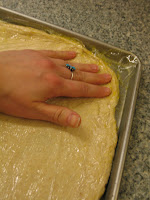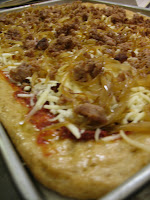(Otherwise known as the exhaustive biscuit post)
I once heard a particular scathing remark for those who don't learn how to cook: shotgun biscuits. "It sounds like a gun done gone off in the kitchen..."
Ahem. These are not those biscuits. You see, you can't develop any sort of reputation as a cook in the South with those ungodly things. The truth be told, those biscuits can do many things when you're in a tremendous hurry, as many TV darlings with deep southern accents have proven. It still doesn't make them taste any better, though-- doughy and generic flavor that comes from oils produced from who-knows-what.
I have a couple of biscuit recipes that I keep in my overflowing recipe collection for whenever the urge strikes. For no matter how much I may need protein in the morning, sometimes nothing but biscuits and gravy will do.
I do have one caveat about my biscuits: I always, always use half whole wheat (soft white) and half all-purpose flour. Sometimes I'll even use all whole-wheat. The half-n-half thing actually makes most people think it tastes better.
I also find that some have issues with cutting flour into butter (or whatever fat you're using). It's a skill better learned by experience rather than taught, but it's something you can also see-- though it's even better to feel it with your fingers. Honestly, it's better to underdo it rather than overdo it. If you overdo it, you'll end up with a gluey mess and biscuits that won't rise. If you leave larger pieces of fat in your dough, you'll just end up with puddles of butter in your dough, which will eventually make holes. That doesn't do much-- it just makes your biscuits flakier. :)
 This is what looks right to me: all of the flour is coated with fat, but there are still larger pieces of butter in the mix. Those larger pieces will create flakiness, which make your biscuits tender. This is especially essential if you're planning on shaping your biscuits. You need those larger chunks of fat in there to support the turning and flouring and patting down and rolling out that your dough will go through.
This is what looks right to me: all of the flour is coated with fat, but there are still larger pieces of butter in the mix. Those larger pieces will create flakiness, which make your biscuits tender. This is especially essential if you're planning on shaping your biscuits. You need those larger chunks of fat in there to support the turning and flouring and patting down and rolling out that your dough will go through.
I also use a pastry blender rather than a fork or my fingers. If I'm in a kitchen without one, I'll cut my butter into small (1/2-inch) pieces, use my fingers for a while, and end with a fork. I'll also use the food processor when I have large quantities of flour and fat. It all depends on your comfort and your tools.
Easy Drop Biscuits

This first recipe is one I mastered as a teenager, intent on imitating my aunt D's skills as a baker. It's really her recipe, tried and true, from many family get-togethers. Of course, my aunt probably has more biscuit recipes than a butcher has cuts of meat, but this is the one I remember the best. Mine never turn out exactly like hers; I think it's in the way she shapes them, and the way I don't. These are lazy-day biscuits, for when you don't feel like getting out your
pastry mat or your
biscuit cutters. This is also the recipe I use when I want to throw in cheese, chives, spices, and other lovely things. They're incredibly flexible. They also make up for their ugliness by being melt-in-your mouth good, and they need nothing to make them better. (Not that a little maple syrup or honey hurt anyone... :)
These biscuits are also so fast that you can whip up a batch for Sunday lunch
after you get in from church, while everything else is warming up.
2 c. all-purpose flour (half soft white, half all-purpose)
4 t. baking powder
1/2 t. salt
2-4 T. sugar (depending on how sweet you want your biscuits--two is perfect for most)
1/2 c. butter
2/3 c. sweet milk
Preheat oven to 450 (230 C)
Mix all dry ingredients together in a large bowl. Cut the butter into 1-inch pieces, and using your fingers, a fork, or a pastry blender, cut butter into flour. When the largest lumps of butter are pea-sized and the rest of the dough resembles coarse cornmeal, add in milk. Mix very briefly. Drop in mounds onto a baking sheet (you can use parchment, if desired). Bake for 7-10 minutes, depending on the size of your biscuits.
(You
can shape these to make them more uniform: using floured hands, gently round spoonfuls of dough between your palms and put them, barely touching, in a high-sided pan to
bake.
Cheese and chive variation: (or, the Red Lobster version)
Reduce sugar to one tablespoon; add in 1/2 c. cheese and 2 Tablespoons finely chopped/cut fresh chives right before adding in the milk. You can also 1/2 t. minced garlic.
Cinnamon and spice variation:Mix in 1 t. cinnamon, 1/4 t. nutmeg, and 1/4 t. cloves into dry ingredients before cutting in butter. In a separate bowl, mix together 2 Tablespoons sugar, 1 teaspoon cinnamon and 1 Tablespoon butter. Drizzle the cinnamon-sugar topping over biscuits before baking.
---
Sky-High Biscuits

If I'm really in the mood for butter and jam, what I want are my Uncle D's biscuits. (Well, really, he's my second cousin. He just treats me so well, I feel like his niece instead.) When I visited him and Aunt B. last fall, I woke up one morning to D. mixing up this recipe. I'm not sure anyone can make these biscuits quite as well as he does, but I'm still trying. When made right, these biscuits are beautifully buttery, fluffy and--the name doesn't lie--sky-high. An appropriate name for a recipe that comes from a former Air Force pilot, no?
These biscuits have a similar delicate flavor to the ones above, but they are built for butter and jam. They remind me of what's best about baking powder biscuits.
3 cups all-purpose flour (half soft white, half all-purpose)
2 Tablespoons baking powder
3 Tablespoons sugar
1/2 teaspoon salt1 teaspoon cream of tartar
3/4 c. butter
1 egg, beaten
1 c. milk
Preheat oven to 450 F (230 C).
Combine all dry ingredients in a bowl. Add butter, cut in until crumbly.
Mix together beaten egg and milk; add to flour mixture and mix quickly. Knead lightly, folding dough over itself to build layers.
Pat gently to about one inch thickness and cut into 2-inch biscuits. Place slightly apart on a cookie sheet; bake for 15 minutes.
---
Heavenly Flour-Bread Biscuits (or in Southern vernacular, Angel Biscuits)from
Dori Sander's Country Cooking
The last biscuits, I'm almost beyond words to describe. They aren't a bit like the other two--because they include less fat, copious amounts of buttermilk,
lard, and
yeast. Yes--though most don't consider yeast to be a part of biscuits, they are in this recipe. And it makes these biscuits wonderfully hassle-free and delicious. Because these contain yeast, I usually start the dough the night before and place it in the fridge. The next morning, all I have to do is roll out the dough and cut them out-- though I usually fold the dough several times (as you would puff pastry) to make sure it's the right consistency. This also helps the dough develop layers, which makes it a great pull-apart-with-your-fingers kinda biscuit. The other great thing about this recipe? They taste good for at least one day after they're freshly made, sometimes two--but only if you use lard. I've made them with all butter before, and they just weren't as good.
This makes a massive amount of biscuits, but don't fear, you will use them up. You could also halve the recipe or freeze the leftovers.
1 Tablespoon dry active yeast
2 Tablespoons warm water
5 cups all-purpose flour (half soft white, half all-purpose)
2 teaspoons baking powder
1 teaspoon salt
1/4 cup sugar
1 cup lard or butter (I use 6.5 ounces of lard and 1.5 (3 Tablespoons) of butter)
2 cups buttermilk
In a medium bowl, dissolve the yeast in the warm water. Set aside.
In a large bowl, sift together the flour, sugar, baking powder, and salt. Cut in the shortening with a pastry blender until the mixture resembles very coarse cornmeal. (I usually use a food processor.)
Add the buttermilk to the yeast water, stir, and add to the flour mixture. Stir until the mixture is just moistened. The dough, which will be very soft, may be covered and refrigerated overnight at this point. (I always do this.)
Preheat the oven to 400 F (200 C). Turn the dough out onto a floured surface, sprinkle the top lightly with flour, and knead 6-8 times. Reflour the surface and roll the dough out to a thickness of a bout 1/2 inch. Using a biscuit cutter dipped in flour, cut into rounds and place on a lightly greased (or parchment-lined) baking sheet. For lighter biscuits, cover with a towel and let rise in a warm place for twenty minutes. For quick biscuits, proceed directly to baking.
Bake in the preheated oven for 15-20 minutes or until golden. Serve warm.






























